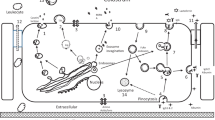Abstract
Background
Colostrum contains a wide variety of crucial nutritional elements including growth factors for newborn infants to adapt to the extrauterine environment.
Objective
To investigate the clinical significance of epidermal growth factor receptor ligands in milk during the first month of lactation.
Methods
The concentrations of epidermal growth factor (EGF), amphiregulin (AR) and transforming growth factor-α (TGF-α) in milk sampled from a total of 31 normal mothers at days 1–3, 5, and 30 postpartum were examined using ELISA.
Results
At days 1–3, the concentration of EGF was extremely high [131.6 ± 20.4 (mean ± SEM) ng/ml] compared to that of AR (4,197.2 ± 1,055.2 pg/ml) or TGF-α (261.7 ± 33.6 pg/ml), while the concentration of AR was significantly elevated compared to that of TGF-α. At days 5 and 30, the concentration of EGF was significantly elevated compared to that of AR or TGF-α. In 16 mothers among the same 31 subjects, samples were longitudinally obtained on days 1, 2, 5, and 30 postpartum. Concentrations of AR were higher on days 1 and 2 and rapidly declined to below 1 ng/ml on day 5, and were maintained at lower levels on day 30. Concentrations of EGF were high on day 1 (greater than 10 ng/ml) but gradually declined by days 2, 5, and 30. Concentrations of TGF-α remained at lower levels of below 1 ng/ml throughout the lactation period from days 1 to 30.
Conclusion
These results suggested that EGF and amphiregulin in colostrum might contribute to the early stage of development of neonatal gastrointestinal function.


Similar content being viewed by others
References
Playford RJ, Macdonald CE, Johnson WS (2000) Colostrum and milk-derived peptide growth factors for the treatment of gastrointestinal disorders. Am J Clin Nutr 72:5–14
Sullivan PB, Brueton MJ, Tabara ZB, Goodlad RA, Lee CY, Wright NA (1991) Epidermal growth factor in necrotising enterocolitis. Lancet 338:53–54
Dvorak B, Halpern MD, Holubec H, Williams CS, McWilliam DL, Dominguez JA, Stepankova R, Payne CM, McCuskey RS (2002) Epidermal growth factor reduces the development of necrotizing enterocolitis in a neonatal rat model. Am J Physiol Gastrointest Liver Physiol 282:G156–G164
Clark JA, Doelle SM, Halpern MD, Saunders TA, Holubec H, Dvorak K, Boitano SA, Dvorak B (2006) Intestinal barrier failure during experimental necrotizing enterocolitis: protective effect of EGF treatment. Am J Physiol Gastrointest Liver Physiol 291:G938–G949
Citri A, Yarden Y (2006) EGF-ERBB signalling: towards the systems level. Nat Rev Mol Cell Biol 7:505–516
Troyer KL, Luetteke NC, Saxon ML, Qiu TH, Xian CJ, Lee DC (2001) Growth retardation, duodenal lesions, and aberrant ileum architecture in triple null mice lacking EGF, amphiregulin, and TGF-α. Gastroenterology 121:68–78
Carpenter G (1980) Epidermal growth factor is a major growth-promoting agent in human milk. Science 210:198–199
Read LC, Upton FM, Francis GL, Wallacc JC, Dahlenberg GW, Ballard FJ (1984) Changes in the growth-promoting activity of human milk during lactation. Pediatr Res 18:133–139
Dvorak B, Fituch CC, Williams CS, Hurst NM, Schanler RJ (2003) Increased epidermal growth factor levels in human milk of mothers with extremely premature infants. Pediatr Res 54:15–19
Okada M, Ohmura E, Kamiya Y, Murakami H, Onoda N, Iwashita M, Wakai K, Tsushima T, Shizume K (1991) Transforming growth factor (TGF)-α in human milk. Life Sci 48:1151–1156
Koyama S, Podolsky DK (1989) Differential expression of transforming growth factors α and β in rat intestinal epithelial cells. J Clin Invest 83:1768–1773
Barnard JA, Polk WH, Moses HL, Coffery RJ (1991) Production of transforming growth factor-alpha by normal rat small intestine. Am J Physiol 261:C994–C1000
Heird WC, Schwarz SM, Hansen IH (1984) Colostrum-induced enteric mucosal growth in beagle puppies. Pediatr Res 18:512–515
Thompson JF, Singh M, Wang Y, Zucker C, Heird WC (1986) Developmental differences in the effect of natural feeding on early enteric mucosal growth of guinea pigs. J Pediatr Gastroenterol Nutr 5:643–647
Xu RJ, Mellow DJ, Tungthanathanich P, Birtles MJ, Reynolds GW, Simpson HV (1992) Growth and morphological changes in the small and the large intestine in piglets during the first three days after birth. J Dev Physiol 18:161–172
Burrin DG, Shulman RJ, Reeds PJ, Davis TA, Gravitt KR (1992) Procine colostrum and milk stimulate visceral organ and skeletal muscle protein synthesis in neonatal piglets. J Nutr 122:1205–1213
Saeki T, Stromberg K, Qi CF, Gullick WJ, Tahara E, Normanno N, Ciardiello F, Kenney N, Johnson GR, Salomon DS (1992) Differential immunohistochemical detection of amphiregulin and crypto in human normal colon and colorectal tumors. Cancer Res 52:3467–3473
Barnard JA, Graves-Deal R, Pittelkow MR, DuBios R, Cook P, Ramsay GW, Bishop PR, Damstrup L, Coffey RJ (1994) Auto- and cross-induction within the mammalian epidermal growth factor-related peptide family. J Biol Chem 269:22817–22822
Luetteke NC, Qiu TH, Fenton SE, Troyer KL, Riedel RF, Chang A, Lee DC (1999) Targeted inactivation of the EGF and amphiregulin genes reveals distinct roles for EGF receptor ligands in mouse mammary gland development. Development 126:2739–2750
Buchmiller TL, Shaw KS, Chopourian HL, Lloyd KC, Gregg JP, Rivera FA Jr, Lam ML, Diamond JM, Fonkalsrud EW (1993) Effect of transamniotic administration of epidermal growth factor on fetal rabbit small intestinal nutrient transport and disaccharidase development. J Pediatr Surg 28:1239–1244
Halpern MD, Dominguez JA, Dvorakova K, Holubec H, Williams CS, Meza YG, Ruth MC, Dvorak B (2003) Ileal cytokine dysregulation in experimental nectorizing enterocolitis is reduced by epidermal growth factor. J Pediatr Gasteroneterol Nutr 36:126–133
Acknowledgments
This study was supported in part by funds (No. 096008) from the Central Research Institute of Fukuoka University.
Conflict of interest
There are no conflicts of interest or competing financial interests related to this work.
Author information
Authors and Affiliations
Corresponding author
Rights and permissions
About this article
Cite this article
Nojiri, T., Yoshizato, T., Fukami, T. et al. Clinical significance of amphiregulin and epidermal growth factor in colostrum. Arch Gynecol Obstet 286, 643–647 (2012). https://doi.org/10.1007/s00404-012-2365-8
Received:
Accepted:
Published:
Issue Date:
DOI: https://doi.org/10.1007/s00404-012-2365-8




